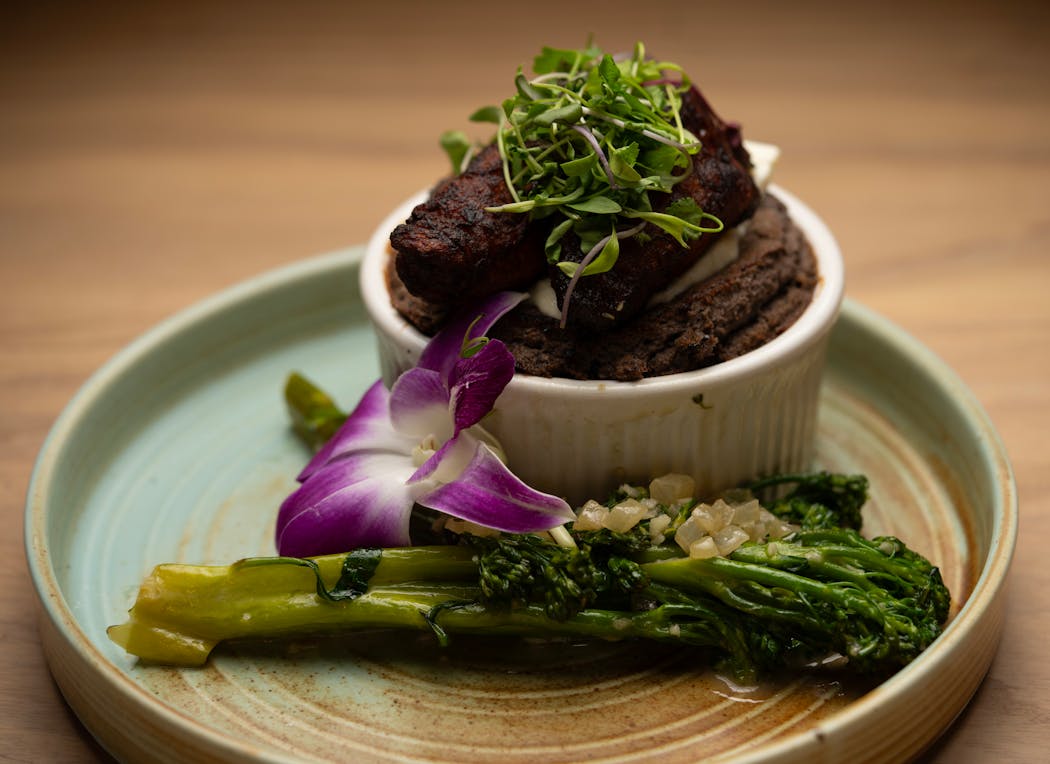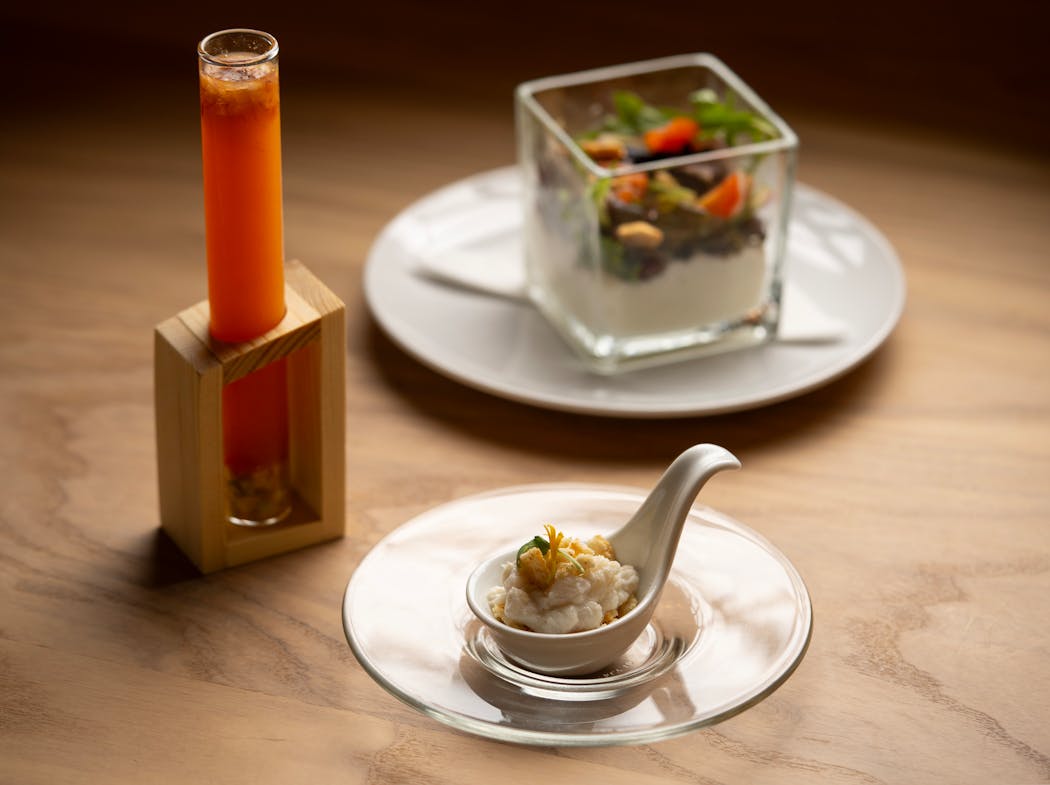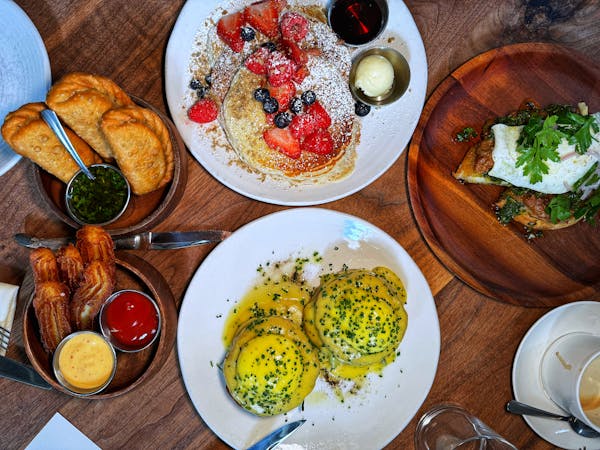The aquamarine floor that spans Crasqui, the restaurant, may at first recall the paint job of polished, psychedelic-looking bowling ball. This is not by design. "Try looking at it after a few drinks," our server suggests.
We do, and it clicks. The undulating swirls dance like seawater lapping against the white leather furniture, the color of which supposedly resembles sand. Crasqui, it turns out, is named after an island off the coast of Venezuela, where the restaurant's chef/owner, Soleil Ramirez, was raised.
But you won't need to be in any stupor to imagine how the space, inside a nondescript building off the Wabasha Street bridge in downtown St. Paul, could match this postcard destination, 3,000 miles south. Food alone does the job. Compellingly, too.
To fully realize this, consider the fresh, creamy, almost saline qualities of coconut with Ramirez's take on fosforera, a Venezuelan soup native to the island of Margarita. To a bowl of gently cooked seafood, a server pours a bisque — a thin but extravagant distillation of shrimp and the coconut. Over tiny kernels of peppers and potatoes, he pours a variation of the broth (crema de coco), equally fragrant from tomatoes and garlic. These are soups I will think of in the howls of winter.
I've never been to Venezuela, but I hope the plantains there taste like the ones I had on a recent evening. They looked like miniature, rusted ingots, roasted until dark, caramelized and pungent, like molasses that had been fermenting all week. I don't think the black beans will ever look primed for Instagram — unless black hole in bowl is a new art form — but your taste buds will beg to differ when you find yourself merrily swiping heaping, nutty spoonfuls of them, as if administered by Mary Poppins.
"Seasonal" vegetables may sound like the neglected dish in any menu, but far from it at Crasqui. They have a kind of crunch that many kitchens across town don't normally achieve, while the seafood stock in which the vegetables are cooked imbues it with complexity. You may overlook the seasonal sorbet, too. Don't. I've had mangoes in the tropics that were less vivid than the way it's captured here, in puddinglike form.
If the simplicity of these dishes doesn't entice you, you may be missing the point. There is a diaspora of ways to express heritage and voice, of which Ramirez is a steward. Seven years ago, Ramirez fled Venezuela when corrupt government officials seized the money cobbled from the restaurant she helped run. She arrived in the United States with $300 and a week's worth of clothes, in search of asylum and opportunity.
She found both. After working for luminary chefs, including the late Jack Riebel, Ramirez built an eatery of her own and named it Arepa Bar, where she vends homier street food staples in addition to the namesake product. The profits from the operation inside Midtown Global Market — and her own savings — helped finance Crasqui, which she opened in early in August.
There are arepitas here, and they range from fair to very good, including a smoky, creamy one with a mild Guyanese cheese. But you're better off grazing elsewhere on the menu, if even for the easier-listening classics, which may sound like an attempt to promote familiarity among the less adventurous. It isn't, really. Not when burrata is paired with mojo, a kind of Los Andean green salsa, forthright and bright from the peppers. Or when the carpaccio here — a thin, outstretched blanket of beef under dabs of parsley aioli and capers — is clammier than the ones you know. Or when chicharron is less like the little nubs of fried pork belly you remember, and more like a pair of paddle-sized wedges thick enough to journey from crackling to gelatinous. It sits on a pool of guasacaca — a looser, more vinegar-forward guacamole that I wish would become more commonplace.
Yes, there are faults. The fosforera was watered down the second time I had it, when the restaurant neared capacity. The pork chop (dry) was an afterthought alongside a heady mora sauce and meltingly soft fondant potatoes. A better option would have been the rib-eye, which is less banal than it sounds mainly because it comes with morcilla, a livery, gloriously funky blood sausage.
In a couple of instances, balance was an issue. A beet salad lacked acid, and the jellified cubes of passion fruit could be sweeter. Grouper ceviche similarly could use that jolt, more to counter the taste (fishy) and texture (sinew-forward).
And in others, creativity can go rogue. I'd much prefer black beans when they're served on their own, not in a soufflé that ate heavy and nondescript. A better starch is the al dente, squid-ink risotto, which was appealingly briny.
Executions can fall flat with a menu this vast, and it can get overwhelming. One suggestion from the server, during my most recent visit, was to order the tasting menu, which charts Ramirez's journey throughout Venezuela over six courses.
It began with a choice of a salad or that crema de coco, then to a gazpacho that was presented as a vial of what looked like a medicinal shot you'd take when your throat feels a tickle. But it's way more: vegetal, floral, and deeply evocative of orange.
You may encounter gently chewy croquettes in a fine (if uninspired) coulis that tasted little of peppers; or another ceviche topped with pretty (if slightly strange) guava pearls; or an entree with scallops that range in size from regular to miniatures, which led to uneven cookery. At least the mango chutney nestled within was a triumph, so were the teardrop-shaped chistorra, a Basque-style sausage — juicy, meaty and crisp.
While you do end on a high note with dessert — choice between the godly sorbet or an equally impressive cocotero, which pairs boozy rum cake and coconut foam, all encased in its husk — it's difficult to justify the cost, $120. This pits it against the other storied restaurants around town that offer similarly priced menus with more generosity and finesse.
I would pay dearly for Ramirez's a la carte sea bass, though. It's a $42 showcase of how to cook a fatty fish until the interior multiplies into milky slabs and the exterior bronzes. No other restaurant compares. Plus: that mango salsa is nuanced, and the shrimp is bouncy and sweet.
Whichever adventure you choose will bring pleasure, bewilderment, or both. It's all part of Soleil Ramirez's world — bold, colorful, with a sense of escapism. What a privilege for us to be living in it.
Crasqui
⋆⋆⋆ highly recommended
Location: 84 Wabasha St., Suite 3, St. Paul, 952-600-5578, crasquirestaurant.com
Hours: Tue.-Thu. 5-9 p.m., Fri.-Sat. 5-10 p.m., Sun. 11 a.m.-8 p.m.
Prices: Appetizers $15-$24, soups and salads $15-$17, mains $24-$42. Sides are $12, ranging from seasonal vegetables and plantains to black beans and arepitas.
Beverage program: A selection of creative — and potent — craft cocktails ($14-$16); a tightly curated wine and beer list, plus a handful of spirit-free options beyond soda.
Tip or no tip: An 8% wellness charge is added to all checks; tipping additional.
Noise level: Comfortable, even when busy.
Worth noting: Brunch is served on Sundays from 11 a.m.-3:30 p.m., with a menu of arepas, sweet corn pancakes, and select dishes from the dinner menu. And, there's free (and plentiful) parking in the retail lot adjacent to the building.
What the stars mean:
⋆⋆⋆⋆ Exceptional
⋆⋆⋆ Highly recommended
⋆⋆ Recommended
⋆ Satisfactory
Jon Cheng is the Star Tribune's restaurant critic. Reach him at jon.cheng@startribune.com or follow him at @intrepid_glutton.

The 5 best things our food writers ate this week

A Minnesota field guide to snow shovels: Which one's best?

Summer Camp Guide: Find your best ones here

Lowertown St. Paul losing another restaurant as Dark Horse announces closing





